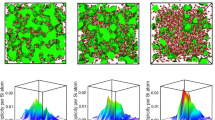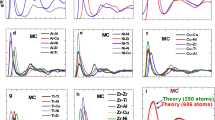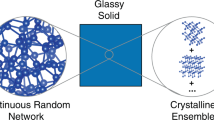Abstract
The atomic structure of metallic glasses has been a long-standing scientific problem. Unlike crystalline metals, where long-range ordering is established by periodic stacking of fundamental building blocks known as unit cells, a metallic glass has no long-range translational or orientational order, although some degrees of short- and medium-range order do exist1,2,3. Previous studies1,2,3,4 have identified solute- (minority atom)-centred clusters as the fundamental building blocks or short-range order in metallic glasses. Idealized cluster packing schemes, such as efficient cluster packing on a cubic lattice1 and icosahedral packing3 as in a quasicrystal, have been proposed and provided first insights on the medium-range order in metallic glasses. However, these packing schemes break down beyond a length scale of a few clusters. Here, on the basis of neutron and X-ray diffraction experiments, we propose a new packing scheme—self-similar packing of atomic clusters. We show that the medium-range order has the characteristics of a fractal network with a dimension of 2.31, and is described by a power-law correlation function over the medium-range length scale. Our finding provides a new perspective of order in disordered materials and has broad implications for understanding their structure–property relationship, particularly those involving a change in length scales.
This is a preview of subscription content, access via your institution
Access options
Subscribe to this journal
Receive 12 print issues and online access
$259.00 per year
only $21.58 per issue
Buy this article
- Purchase on Springer Link
- Instant access to full article PDF
Prices may be subject to local taxes which are calculated during checkout



Similar content being viewed by others
References
Miracle, D. B. A structural model for metallic glasses. Nature Mater. 3, 697–702 (2004).
Miracle, D. B. The efficient cluster packing model—an atomic structural model for metallic glasses. Acta Mater. 54, 4317–4336 (2006).
Sheng, H. W. et al. Atomic packing and short-to-medium-range order in metallic glasses. Nature 439, 419–425 (2006).
Ma, D. et al. Nearest-neighbor coordination and chemical ordering in multicomponent bulk metallic glasses. Appl. Phys. Lett. 90, 211908 (2007).
Manderlbrot, B. B. The Fractal Geometry of Nature (W. H. Freeman, 1983).
Gouyet, J.-F. Physics and Fractal Structures (Springer, 1996).
Freltoft, T., Kjems, J. K. & Sinha, S. K. Power-law correlations and finite-size effects in silica particle aggregates studied by small-angle neutron scattering. Phys. Rev. B 33, 269–275 (1986).
Weitz, D. A., Huang, J. S., Lin, M. Y. & Sung, J. Dynamics of diffusion-limited kinetic aggregation. Phys. Rev. Lett. 53, 1657–1660 (1984).
Feder, J., Jossang, T. & Rosenqvist, E. Scaling behaviour and cluster fractal dimension determined by light-scattering from aggregating proteins. Phys. Rev. Lett. 53, 1403–1406 (1984).
Elliott, S. R. Physics of Amorphous Materials (Longman, 1984).
Borjesson, L., McGreevy, R. L. & Howells, W. S. Fractal aspects of superionic glasses from reverse Monte-Carlo simulations. Phil. Mag. B 65, 261–271 (1992).
Fontana, A. et al. Low-frequency dynamics in superionic borate glasses by coupled Raman and inelastic neutron scattering. Phys. Rev. B 41, 3778–3785 (1990).
Cullity, B. D. & Stock, S. R. Elements of X-Ray Diffraction (Prentice Hall, 2001).
Wang, X. L. The application of neutron diffraction to engineering problems. JOM 58, 52–57 (2006).
Guinier, A. X-Ray Diffraction: in Crystals, Imperfect Crystals, and Amorphous Bodies (Dover, 1994).
Elliott, S. R. Medium-range structural order in covalent amorphous solids. Nature 354, 445–452 (1991).
Mattern, N. et al. Short-range order of Zr62−xTixAl10Cu20Ni8 bulk metallic glasses. Acta Mater. 50, 305–314 (2002).
Altounian, Z. & Stromolsen, J. O. Superconductivity and spin fluctuations in Cu–Zr, Ni–Zr, Co–Zr and Fe–Zr metallic glasses. Phys. Rev. B 27, 4149–4156 (1983).
Buschow, K. H. J. Short-range order and thermal-stability in amorphous-alloys. J. Phys. F 14, 593–607 (1984).
Calvayrac, Y. et al. On the stability and structure of Cu–Zr based glasses. Phil. Mag. B 48, 323–332 (1983).
Price, D. L. et al. Intermediate-range order in glasses and liquids. J. Phys. C 21, L1069–L1072 (1988).
Jiang, Q. K. et al. La-based bulk metallic glasses with critical diameter up to 30 mm. Acta Mater. 55, 4409–4418 (2007).
Xi, X. K., Zhao, D. Q., Pan, M. X. & Wang, W. H. Highly processable Mg65Cu25Tb10 bulk metallic glass. J. Non-Cryst. Solids 344, 189–192 (2004).
Li, S. et al. Formation and properties of RE55Al25Co20 (RE=Y, Ce, La, Pr, Nd, Gd, Tb, Dy, Ho and Er) bulk metallic glasses. J. Non-Cryst. Solids 354, 1080–1088 (2008).
Mancini, L. et al. Hierarchical porosity in real quasicrystals. Phil. Mag. Lett. 78, 159–167 (1998).
Janot, C. & Deboissieu, M. Quasi-crystals as a hierarchy of clusters. Phys. Rev. Lett. 72, 1674–1677 (1994).
Takakura, H. et al. Atomic structure of the binary icosahedral Yb–Cd quasicrystal. Nature Mater. 6, 58–63 (2007).
Sachdev, S. & Nelson, D. R. Order in metallic glasses and icosahedral crystals. Phys. Rev. B 32, 4592–4606 (1985).
Sheng, H. W., Ma, E., Liu, H. Z. & Wen, J. Pressure tunes atomic packing in metallic glass. Appl. Phys. Lett. 88, 171906 (2006).
Cargill, G. S. III. in Solid State Physics Vol. 30 (eds Feitz, F., Turnbull, D. & Ehrenreich, H.) 227–320 (Academic, 1975).
Manoharan, V. N. & Pine, D. J. Building materials by packing spheres. MRS Bull. 29, 91–95 (2004).
Nugent, C. R., Edmond, K. V., Patel, H. N. & Weeks, E. R. Colloidal glass transition observed in confinement. Phys. Rev. Lett. 99, 025702 (2007).
Schall, P., Weitz, D. A. & Spaepen, F. Structural rearrangements that govern flow in colloidal glasses. Science 318, 1895–1899 (2007).
Greer, A. L. & Ma, E. Bulk metallic glasses: At the cutting edge of metals research. MRS Bull. 32, 611–615 (2007).
Yang, B., Liu, C. T. & Nieh, T. G. Unified equation for the strength of bulk metallic glasses. Appl. Phys. Lett. 88, 221911 (2006).
Sietsma, J. & Thijsse, B. J. An investigation of universal medium range order in metallic glasses. J. Non-Cryst. Solids 135, 146–154 (1991).
Orbach, R. Dynamics of fractal networks. Science 231, 814–819 (1986).
Poulsen, H. F. et al. Measuring strain distributions in amorphous materials. Nature Mater. 4, 33–36 (2005).
Acknowledgements
We thank Z. P. Lu and M. J. Kramer for providing the metallic-glass samples, H. Bei for help in density measurements and S. E. Nagler for helpful discussions. This research was supported by US Department of Energy, Office of Basic Energy Sciences, under Contract DE-AC05-00OR22725 with UT-Battelle, LLC.
Author information
Authors and Affiliations
Corresponding author
Rights and permissions
About this article
Cite this article
Ma, D., Stoica, A. & Wang, XL. Power-law scaling and fractal nature of medium-range order in metallic glasses. Nature Mater 8, 30–34 (2009). https://doi.org/10.1038/nmat2340
Received:
Accepted:
Published:
Issue Date:
DOI: https://doi.org/10.1038/nmat2340
This article is cited by
-
Characterizing Structural Heterogeneity in Metallic Glasses: A Molecular Dynamics-Guided Machine Learning Approach
Transactions of the Indian Institute of Metals (2024)
-
Local atomic structure studies of Zr55Cu35Al10 alloy around Tg
Scientific Reports (2023)
-
Emergence of equilibrated liquid regions within the glass
Nature Physics (2023)
-
Enhancement of short/medium-range order and thermal conductivity in ultrahard sp3 amorphous carbon by C70 precursor
Nature Communications (2023)
-
Composition dependence of polyamorphic transition in Pd–Ni–P metallic glasses
Science China Materials (2023)



